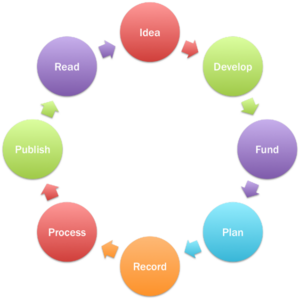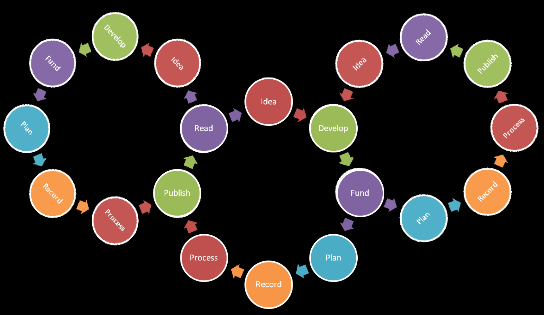| I have just been at a wonderful conference in Canyons, Utah “Accelerating discovery: Human-computer symbiosis 50 years on” (https://sites.google.com/site/licklider50/ ). This drew from Lick’s vision – 50 years ago – of machines and humans interacting in a symbiosis to help each other by contributing the things they are good at. And I’ll write more about this. But a surprisingly large amount of the meeting was about scientific “publishing”. In large part because it is critical to modern machine intelligence which looks at how knowledge can be used by computers. If we publish data, then computers can use that. (If we don’t, they can’t). And most of the time we do not publish our work. Surely “publish or perish”? If academics don’t publish, they don’t advance – and may get terminated. True – but it’s often a special type of “publication”. Publication only readable by academics, because only they have libraries which subscribe to these publications. And often not even read by them. Used primarily for the purpose of evaluating the worth of academics and their institutions. And, as I have started to argue here and shall continue, it’s not even very good at doing this. One of the scientists at licklider50 was Cameron Neylon – a great proponent of Open science (and who has talked about this at the PMR hackfest earlier). For “technical reasons” I have used an earlier version of his slides (2009) to illustrate my argument (http://www.slideshare.net/CameronNeylon/nesta-science-in-society. ) Here is his model of the scholarly research cycle  And how it can be linked to other scientists so that ideas and publications spread…  But the diagram also (unconsciously or serendipitously) highlights the primary problem with academic research: It’s CLOSED. It’s closed in that the communication process is primarily to other scientists (IN RICH UNIVERSITIES). It does not reach to scientists outside the “top” universities. One research project that I heard about at licklider50 was Open Source Drug Discovery (OSDD). In India. Its aim is to discover new compounds active against tuberculosis. [I’ll write more later]. Because one person dies every three minutes of tuberculosis. The people working on this project don’t even have roads to their houses. But they do have mobile connections. And they have a passionate desire to develop new medicines. But they don’t have full access to the outputs of modern research. Because it’s closed to all except rich universities. And it’s not just India. Here’s an example of a non-university scientist in the West. Sounds like a medical charity. They are seriously disadvantaged by the current system.  So what’s wrong? The aims of many academic researchers. Somehow their vision has got transformed into a simple cycle:
The primary purpose of publication for most academics is self-advancement. |
-
Recent Posts
-
Recent Comments
- pm286 on ContentMine at IFLA2017: The future of Libraries and Scholarly Communications
- Hiperterminal on ContentMine at IFLA2017: The future of Libraries and Scholarly Communications
- Next steps for Text & Data Mining | Unlocking Research on Text and Data Mining: Overview
- Publishers prioritize “self-plagiarism” detection over allowing new discoveries | Alex Holcombe's blog on Text and Data Mining: Overview
- Kytriya on Let’s get rid of CC-NC and CC-ND NOW! It really matters
-
Archives
- June 2018
- April 2018
- September 2017
- August 2017
- July 2017
- November 2016
- July 2016
- May 2016
- April 2016
- December 2015
- November 2015
- September 2015
- May 2015
- April 2015
- January 2015
- December 2014
- November 2014
- September 2014
- August 2014
- July 2014
- June 2014
- May 2014
- April 2014
- March 2014
- February 2014
- January 2014
- December 2013
- November 2013
- October 2013
- September 2013
- August 2013
- July 2013
- May 2013
- April 2013
- March 2013
- February 2013
- January 2013
- December 2012
- November 2012
- October 2012
- September 2012
- August 2012
- July 2012
- June 2012
- May 2012
- April 2012
- March 2012
- February 2012
- January 2012
- December 2011
- November 2011
- October 2011
- September 2011
- August 2011
- July 2011
- May 2011
- April 2011
- March 2011
- February 2011
- January 2011
- December 2010
- November 2010
- October 2010
- September 2010
- August 2010
- July 2010
- June 2010
- May 2010
- April 2010
- August 2009
- July 2009
- June 2009
- May 2009
- April 2009
- March 2009
- August 2008
- July 2008
- June 2008
- May 2008
- April 2008
- March 2008
- February 2008
- January 2008
- December 2007
- November 2007
- October 2007
- September 2007
- August 2007
- July 2007
- June 2007
- May 2007
- April 2007
- December 2006
- November 2006
- October 2006
- September 2006
-
Categories
- "virtual communities"
- ahm2007
- berlin5
- blueobelisk
- chemistry
- crystaleye
- cyberscience
- data
- etd2007
- fun
- general
- idcc3
- jisc-theorem
- mkm2007
- nmr
- open issues
- open notebook science
- oscar
- programming for scientists
- publishing
- puzzles
- repositories
- scifoo
- semanticWeb
- theses
- Uncategorized
- www2007
- XML
- xtech2007
-
Meta

\I think the most realistic action is by funders being really tough on grantees. Absolutely insisting that their funding goes to making sure that outputs are OPEN.\
I agree that this is the way forward. Many funding agencies exist to promote science, and nothing easier to achieve that by going Open.
Thanks Egon
Pingback: Speculative Diction | More than a storm in a teacup: The debate on academic blogging | University Affairs